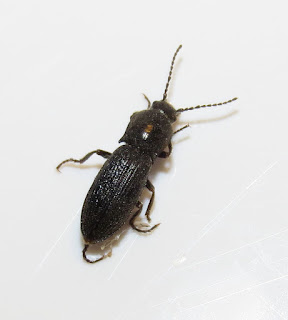I can't make this stuff up. Here I am just walking my neighborhood for exercise yesterday, as I try to do on a daily basis, and limping across the sidewalk comes a little (6-7 mm) click beetle. I put it in a vial, bring it home, and take a couple of pictures. Because I am curious, and I know that "bug folks" on Facebook are starved for stimuli during the winter, I post the images in a beetle group. How should I know that would be genuinely exciting?
My first stop online was the "Friends of Coleoptera [beetles] at the Natural History Museum" group on Facebook. The group is hosted by curators at the Natural History Museum in London, England, but beetle experts from all over the world are members of the group and always willing to help with identifications.
As luck would have it, one of my mentors from back when I was a teenager, and then at Oregon State University, is an expert on click beetles (family Elateridae). I knew this, and I knew he was in the Facebook group, but I had no idea when he would be online next, let alone looking at posts in the group. In a matter of minutes, he had put up a comment on my post that exceeded my wildest expectations:
"Anthracopteryx hiemalis. Super-nice find! This is a native winter-active species in a monobasic genus. It is endemic from Laramie south to Westcliffe in the Front Ranges. Never collected it myself."
Translation: This beetle is the only species in that genus, and it has a very restricted geographical range. You could have knocked me over with a feather. What I haven't told my friend yet is that this is actually the second specimen I have found, in the same stretch of sidewalk, under pretty much the same exact conditions. I didn't get around to imaging that first specimen until it was just about to expire, unfortunately, but here you go....
I certainly did not expect to get a species identification, but I took that and went over to Bugguide.net, the foremost online repository of images of North American insects, spiders, and other arthropods, to add my two images. Well, there weren't any others. There was not a species page to put them on. There was not even a page for the genus. Fortunately, I have volunteer editorial privileges, and so I was able to erect the appropriate pages and then put the pictures up. That kind of thing does not happen very often any more. Bugguide is damn comprehensive.
The lesson I learned, and should have learned long ago, actually, is that when it comes to entomology, you can never assume anything. You can never figure that what you observe and record has no significance. Sure, most of the time it won't be earth-shaking in any way. Then, one day when you don't bother making something public, you will be depriving the scientific community of something truly remarkable.
If anyone ever chastises you for sharing an observation of some "common" critter that you personally were unfamiliar with, then the shame is on them. We can all recall learning about a given organism for the first time, and how exciting that was. Scientists have no right to insult anyone for making an effort to learn, contribute, and otherwise share. Thankfully, there are few scholars that arrogant and disrespectful.
So, get out there on warm winter days and start looking for stuff! There are, no doubt, whole communities of winter-active organisms that we are overlooking.







